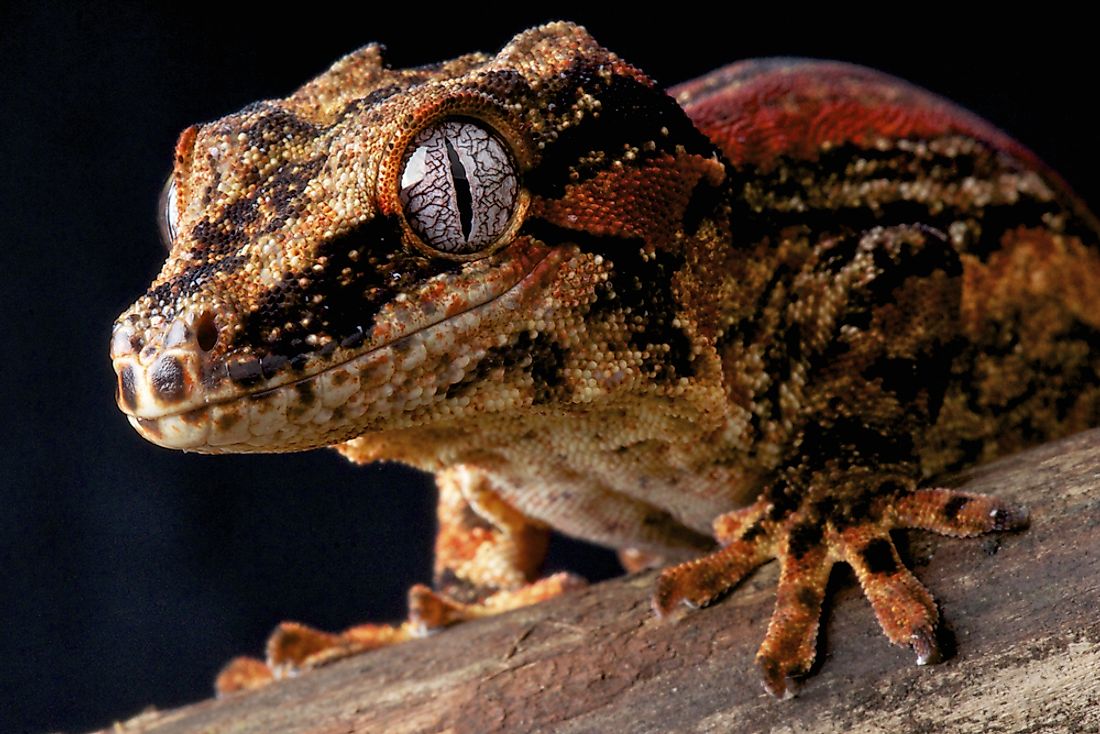Gargoyle Gecko Facts: Animals of Oceania

5. Physical Description
The Gargoyle gecko (Rhacodactylus auriculatus) has an average size and mass of about 8 inches and 60 grams, respectively. The color of these geckos varies between mottled shades of white, grey, brown, and yellow, characterized by a blotchy and striped appearance. The claws of these reptiles allow them to grip rough supports, though they are unable to climb smooth surfaces such as glass using these claws. Their common name, as well as their scientific name of ‘auriculatus’ (meaning 'ear' or 'eared' in Latin), denotes the presence of cranial bumps on their heads, which appears like the ears or horns of a Gargoyle. They have a prehensile tail which can be shed and then regenerated.
4. Diet
Gargoyle geckos have an omnivorous diet, meaning they feed on both plant foods and animals, the latter especially entailing certain insect species. In the wild, these creatures consume fruits and the nectar of plants, and also feed on a wide variety of insects, especially enjoying crickets and locusts. In captivity, these reptiles may be fed fruits and commercially available reptile food products, as well as such live insects as crickets and waxworms. The food for captive Gargoyle geckos might also be dusted with essential vitamins and calcium to enhance the nutritive qualities of their respective diets. Occasionally, these reptiles might also be fed with tiny, pinky mice. In the wild, Gargoyle geckos drink the droplets of water that collect on plants but, in captivity, they can drink water from dishes presented unto them within their enclosures.
3. Habitat and Range
The gargoyle gecko is an endemic species of New Caledonia, an island territory of France in the southwest Pacific Ocean. There, it occupies habitats in the ultramafic blocks of the region with populations of this reptile ranging from southern Grand Terre, to as far north as Dôme de Tiébaghi. The natural habitat of the gecko in the ultramafic substrates of north-west Grand Terre is quite susceptible to damage resulting from the growing Nickel mining industry there. Southern parts of its habitat in this region are also vulnerable to wildfires. Besides these two major threats, this species of reptiles is also subject to predation by such introduced mammals as feral cats, pigs, and rodents. In the past, the wild populations were subject to an illegal pet trade, which has now reduced due the ease with which Gargoyle geckos can be bred in captivity, decreasing the demand of capture of their wild counterparts.
2. Behavior
Gargoyle geckos are primarily arboreal and nocturnal in nature. During the daytime hours, they are rarely spotted out in the open on branches of trees, as they most often remain sheltered in the undergrowth on the ground, or hidden in the cavities of trees. In the night, these creatures start foraging on the stems of small trees and shrubs, and also make a variety of sounds including growls, barks, and squeaks. Less frequently, they might also forage upon the ground. These geckos are very accommodative in captivity, and can easily adapt themselves to the human touch and a captive lifestyle. Male Gargoyle geckos are not always tolerant of one another, and in captivity two males are usually not kept together. Gargoyle geckos are clumsy climbers, as they have a heavy body with small toe pads, which restricts their climbing efficiency to a certain extent.
1. Reproduction
Sexual maturity is reached by Gargoyle geckos at ages of between 12 and 18 months. Males and females are usually aggressive towards each other and, in captivity, the opposite sexes must be brought close only during the breeding period. Their mating ritual is a rough one, often involving bites and injuries inflicted by each of the respective members of the mating pair upon one another. After successful mating, a female lays her eggs after around 20 to 35 days. 2 eggs are laid in 4-5 "clutches" of eggs per year by the female, with an interval of 4 to 6 weeks in between each of the clutches. Incubation temperatures range between 72°F and 83°F, with these incubation temperatures being responsible for sex determination in this species. Gargoyle geckos have an average lifespan of around 15 to 20 years.







